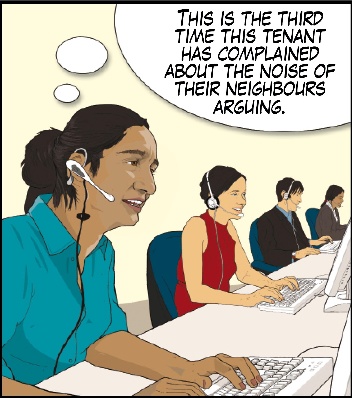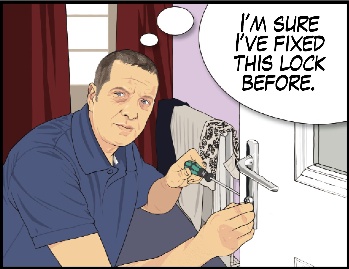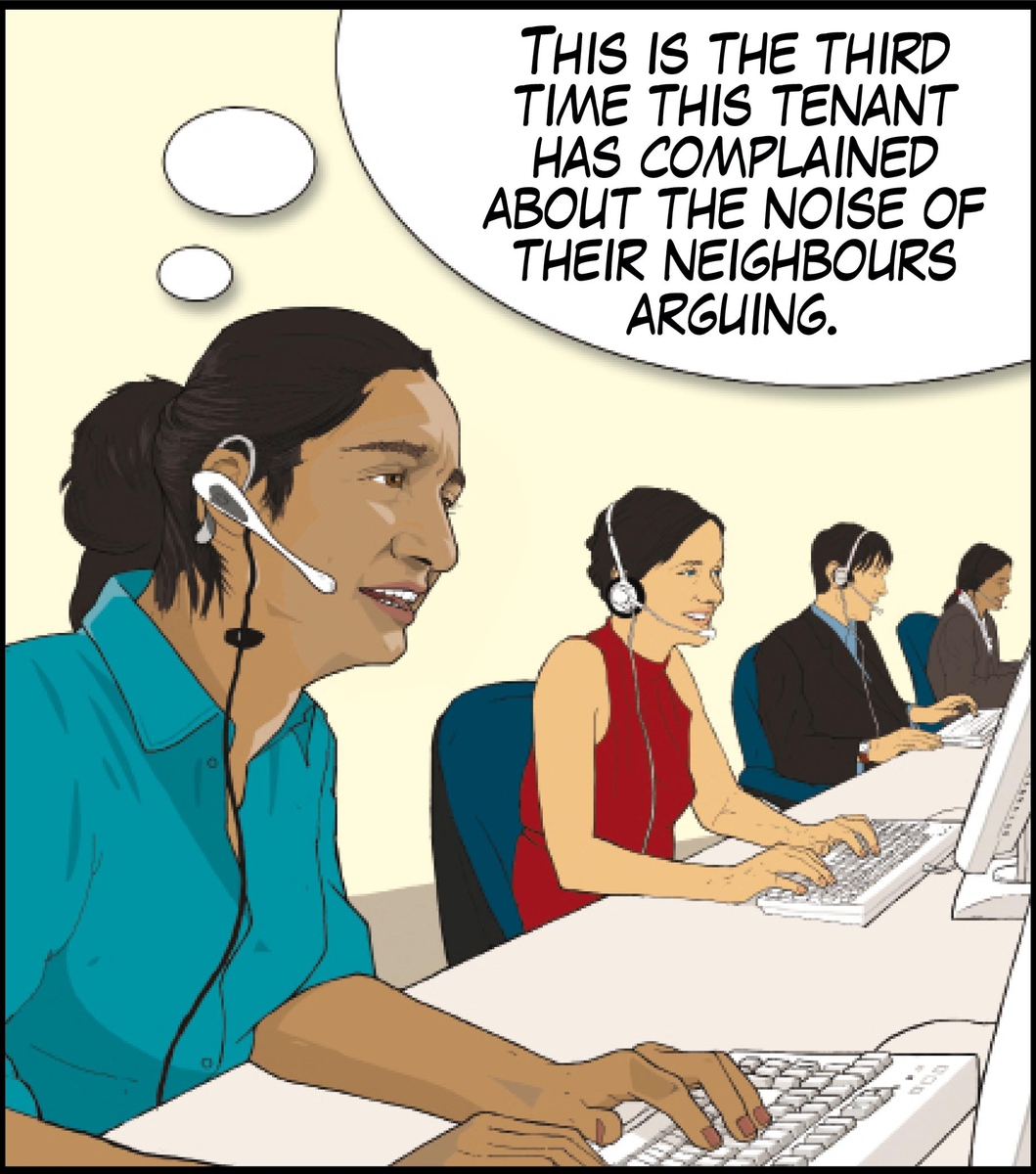Light bulb moment
Housing professionals are ideally placed to identify victims of domestic violence, but only if they know what to look for. Jess McCabe attends a course designed to raise awareness of the problem and help save victims from a life of abuse
Fifteen of us sit around a boardroom table in Peabody’s head office in south London ready to learn about domestic violence.
When Gundrun Burnet, the community safety team leader at Peabody who is leading today’s session, says one in four women will experience domestic abuse during their lifetime, Tim*, who is sitting next to me, leans over. ‘It depends how you define abuse’, he whispers conspiratorially.
Ms Burnet encounters sceptics every time she runs one of these sessions, but she remains an enthusiastic ball of energy, bouncing around the room for the entire six hours of the training day - despite the often grim subject matter. ‘I just get so passionate about this issue,’ she explains.
It’s not difficult to see why she feels so strongly - at one point she cites a case in which Peabody received a complaint from a neighbour about noise nuisance, which turned out to be the sound of a tenant being raped by her husband.
Inside Housing has recently reported how domestic violence services across the UK are under increasing pressure. Funding for refuges is being squeezed to the point where those on the front line fear for the lives of people who are suffering behind closed doors with dwindling options of where to turn for a way out.
Bucking the trend
While resources are being cut elsewhere, a number of housing providers are stepping up to the plate. Peabody is one of them. Every year the 20,000-home social landlord runs 12 training sessions like the one in which Inside Housing is taking part. Through them it has taught swathes of front line staff members how to identify if a tenant is a victim of domestic violence, and how to approach the situation if they believe someone is being abused.
This day-long session, the idea for which Ms Burnet put forward in 2009, has been fully embraced by Steve Howlett, chief executive of Peabody. He admits he’s not participated yet, but plans to. ‘I’m convinced we as a housing association and other housing organisations have an important role to play [in tackling domestic violence],’ he states, explaining that he sees the training as part of the housing association’s role in facilitating safe homes and communities.
The results speak for themselves: in 2007, two years before Peabody began running these courses, four cases of domestic violence were reported to its community safety team over a 12-month period. Now, one case is reported to the team every three days, an increase of more than 1,600 per cent.
Today’s attendees have come mostly from Peabody’s own lettings, tenant and family support and revenues teams. They take the total number of individuals she’s trained to around 160 Peabody staff members and 100 employees from other housing associations.
It costs £150 to put each external participant through the course - money that is ploughed back into the front line work of Peabody’s community safety team.

Source: Jonathan Allardyce
From the outset it’s clear Ms Burnet, who worked directly with domestic violence victims for six years in various roles before joining the housing sector, is not going to sugarcoat the facts she’s about to present.
‘There will be people working here [at Peabody] who are experiencing domestic abuse,’ Ms Burnet says, jumping right in. This session is a safe place, she continues, to talk about your own experiences, or things you’ve seen.
We begin with a quiz designed to test our perceptions of domestic violence. Ms Burnet asks: ‘The UK police receive a call for public assistance for domestic abuse: a) every 10 minutes, b) every minute, or c) every 15 minutes?’
The announcement that the answer is one a minute is met with shocked noises.
On average, how many assaults does a woman endure before contacting the police or another agency for help, asks Ms Burnet. Again, almost no one guesses correctly. The answer is 35. The course leader pauses - this question has practical implications for housing workers.
It is vital that, if someone who is being abused decides to confide in a housing professional, the person they tell doesn’t react with open scepticism, but recognises their bravery in sharing their experience, she explains.
Power and control
Then we turn to examine our sheets displaying the ‘power and control wheel’. The wheel was devised in Minnesota, in the US, in 1984. It draws on the experiences of 200 domestic violence victims to illustrate what an abusive relationship looks, sounds and feels like.
The wheel is divided into segments, which show the most common tactics used by abusers against their victims, which include coercion and threats, intimidation, isolation, and specific examples, such as ‘putting her down’, and ‘controlling what she does and who she sees and talks to’.
The atmosphere in the room becomes tense once we get to the segment about how using male privilege - men ‘acting like the master of the castle’, making all the decisions in a relationship - constitutes abuse. This scratches at the surface of our ideas and assumptions of what a healthy relationship looks like.
Some attendees seem uncomfortable and begin challenging what they are being told. ‘In my culture,’ says one man, ‘this isn’t abuse - it is what
happens.’
‘Where my family’s from,’ another says, ‘this is just how it is.’
Something suddenly clicks for one participant - this sounds like her own parents’ relationship, she says.
Next, we consider common preconceptions about victims. Particularly the question: ‘If things are so bad, why doesn’t she just leave?’ We make a list summing up the costs of leaving a relationship. This list is long and includes being hurt or killed, losing her home, having to move children and losing a partner she may still love despite the abuse.
The benefits of leaving
Collectively we make another list of the benefits of leaving: words like ‘freedom’ and ‘empowerment’ crop up. It’s much shorter.

Source: Jonathan Allardyce
What’s the difference between the two, Ms Burnet asks. The answer is that the losses are practical, tangible and immediate. The benefits are only possibilities; good things that may or may not come to pass.
In the meantime, the victim might be forced to leave their home, often to live in a hostel or refuge - if there is one available. Some refuges report that, so far in 2012, they only have space to accommodate half the women who approach them.
Many in the room want to know if there is a way to evict the perpetrators of domestic violence. Ms Burnet answers that it is possible but that her experience has taught her that often the victim just wants to get on with their life, rather than provide the evidence that would help Peabody with an eviction.
The majority of domestic violence cases are not reported to the police. This means criminal convictions are still rare. ‘In six years I saw two criminal convictions and one was overturned on appeal,’ she says.
Kim Nguyen, an attendee from Peabody, explains that she’s suddenly realised why tenants she’s worked with have, much to her frustration, told their abuser their new address. ‘They might not be able to detach,’ she says. ‘Today has given me a bigger insight into the situation.’
After lunch, the session moves on to some of the more practical questions, such as what to do if a tenant wants to tell you about abuse, but only if you promise to keep it secret? (The answer is not to agree, because safeguarding requirements mean you might not be able to keep the promise).
We go on to talk about the rights of victims if they are made homeless by domestic violence, and we discuss the association’s efforts to re-house victims via, for example, a management transfer - allowing the victim to move to another Peabody home - and to help them keep their tenure if they have to go into a refuge.
Risk assessment
If a domestic violence case is reported to Peabody’s community safety team, Ms Burnet explains, within one working day someone will find a safe way to contact the victim. The aim will be to carry out a risk assessment, using a standardised checklist drawn up by the Association of Chief Police Officers and other agencies.
If the victim scores a certain number of points - usually 14 out of a possible 24 points - on this checklist, they will be referred to a multi-agency risk assessment conference, or Marac. These meetings bring together the police, and other agencies - for example the NHS, probation, social services and housing - with an advocate to ensure the victim’s voice is heard. Actions are then agreed in a co-ordinated fashion to best ensure the victim’s safety.
As today’s training session draws to a close, we have one last exercise to complete, and it’s a role play in which we assess the risk posed to a case study victim.
I am once again paired with Tim, who plays a domestic violence victim called Victoria. Last night, her partner came home from the pub, angry about having lost his job. He threw a glass across the room and cut her leg.
Are you frightened?’ I ask him in my role as the independent domestic violence advisor. He looks at the case study sheet. ‘Yes, I’m frightened,’
he says.
I tot up the scores on the checklist. Victoria has scored 13, one point short of being referred to Marac. ‘Are you sure?’ Tim asks, looking concerned. We run through the results again, both of us are surprised and concerned that Victoria’s case, despite seeming so serious, does not qualify for the intensive Marac intervention.
‘You can feel people’s light bulbs switch on,’ Ms Burnet sums up when we speak after the event - and it’s true.
As we go around the room, the other pairs are similarly troubled by the outcome of the scenario we’ve just examined. We’ve all taken a step towards empathising with Victoria’s character - the light bulbs are definitely glowing.
*Not his real name
Clocking the broken locks
A broken door. A lock smashed in. A hole punched in the wall. These are the kind of repair calls that housing associations receive all the time - a sequence of such problems, however, can be a red flag for domestic violence.
Michelle Meldrum, deputy director at 29,500-home housing association Gentoo in Sunderland, explains: ‘It was a victim we were working with a few years ago. When we pulled together her case file we realised that the home she was living in had a number of repairs of that nature.
‘Someone within the organisation should have clocked that there was a history of broken door locks, holes in doors, and that sort of thing.’
In response, Gentoo implemented a new system in August 2009. The organisation drew up a list of repairs that could indicate domestic violence, which was then given to call centre staff.
When a call comes in to fix one of these problems, they raise a flag on the computer system.
If three flags are raised in 12 months, a referral is made to the association’s victim support team.
So far, 147 potential victims have been identified in this way, and of these 24 have gone on to receive support from Gentoo’s victim support team.










